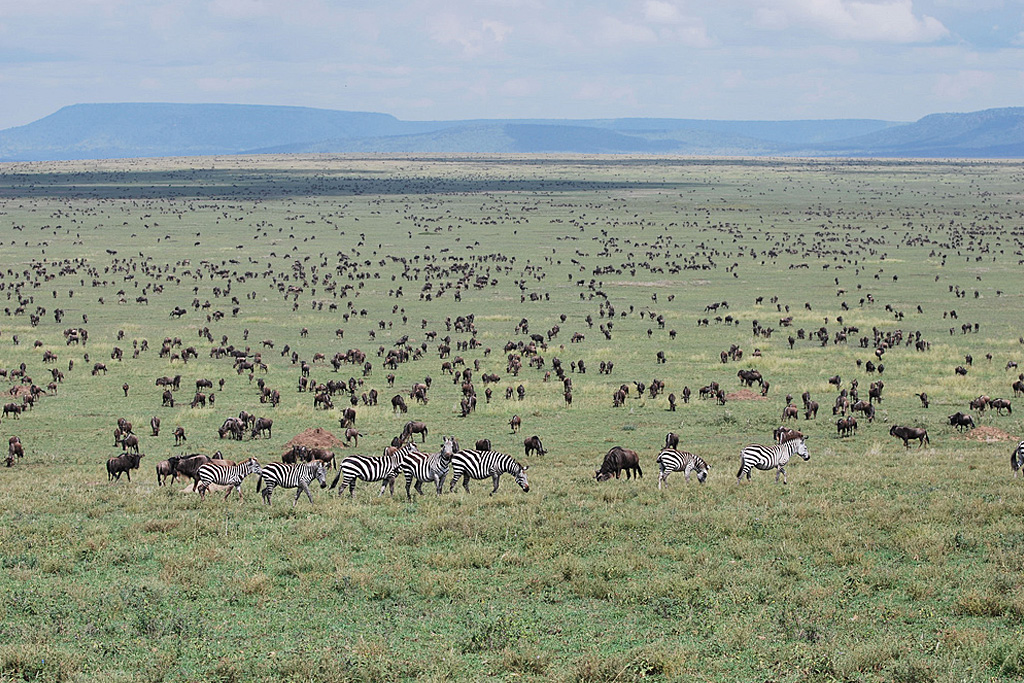 Measuring some 5,700 square miles in size, Serengeti National Park is characterized by a mix of grasslands and plains, riverine forests, and woodlands. Significant is he migration of two species-the white-bearded wildebeest and the plains zebra. The movements of the herds are driven by the dry and wet seasons, with the vast herds setting out for the perennially wet northern landscape when the south becomes dry.
Measuring some 5,700 square miles in size, Serengeti National Park is characterized by a mix of grasslands and plains, riverine forests, and woodlands. Significant is he migration of two species-the white-bearded wildebeest and the plains zebra. The movements of the herds are driven by the dry and wet seasons, with the vast herds setting out for the perennially wet northern landscape when the south becomes dry.
Tourists from around the world are flocking into Tanzania’s Serengeti National Park to witness a unique experience of the wildebeest’s annual birthing season.Wildebeests will deliver new calves in the wilderness of Serengeti plains at the rate of 8,000 newborns a day this season.In the year 2012, more than 16,500 tourists, among them 5,800 domestic visitors, visited the national park to view the wonders of the wildebeests’ calving event.The event also attracted wildlife researchers and zoological scientists.
Serengeti is contiguous with Kenya's Masai Mara, yet this huge area in Tanzania is six times the size. Similar in many ways to the Masai Mara except off road driving is not allowed and during the dry months of summer the great herds have move into Kenya and the narrow channel of the Seronera becomes the most fertile area.
This is the only place on earth where nearly two million herbivores are giving birth at the same time in what is known as synchronised calving.The wildebeests’ calving season is expected to last the next five weeks at the end of which nearly 500,000 calves will be born into Tanzania’s second largest national park.
The animals do not have to lie down but can deliver their babies as they move about,once the calves drop from the wombs, they start hopping about after minutes.Traditionally, February is a low tourism season but more than 18,000 tourists were recordedin this month.Serengeti attracts more than 400,000 tourists annually.The peak tourism season is between the months of June and September when the north-bound great migration of the ungulates takes place.
But most of the half-a-million newborn wildebeests calves will not survive the jungle which is full of preditors like hyenas, lions and leopards, Cheetahs,wolves.Half of the newborn wildebeests are likely to die from predator attacks, drowning in the giant Mara River or succumbing to the hostile elements that accompany the ungulates 1,000 kilometers’ annual migration.The 2010 animal census indicated that there were 1.5 million wildebeests.
The name Serengeti is derived from the word Siringitu, which means -the place where the land moves on forever.The Serengeti National Park itself is part of a larger landscape that includes the Ngorongoro Conservation Area, the Maasai Mara National Reserve in Kenya, and several adjacent game reserves. The area draws more than 90,000 tourists to the region every year.
It's the migration for which Serengeti is most famous. Over a million wildebeest and about 250,000 zebras flow south from the Mara to the southern plains for the short rains every November, and then swirl west and north after the long rains in April, May and June. So strong is the ancient instinct to move that no drought, gorge or crocodile infested river can hold them back.
According to Tanzania’s National Development Corporation (NDC) six foreign firms have submitted bids to establish a $500 million soda ash plant on the shores of Lake Natron. The NDC declined to identify the companies but is currently reviewing the bids. As we’ve reported previously, the planned development of the plant faces harsh opposition from environmental groups. The lake is a sensitive nesting ground for one-third of the world’s population of lesser flamingos, and it is widely feared that the creation of the plant could put the species as a whole at significant risk.
The Tanzanian government is determined to move ahead on the project, claiming that the plant could generate $300 million per year and create 500 jobs. The NDC will hold a 46% stake in the project, and the government has commissioned a wetland management plan and environmental assessment for the proposed site. The assessment is widely expected to call for extraction of soda ash with environmentally-friendly technology, as a way for the government to assuage environmental concerns.
A report by Birdlife International and Wildlife Conservation Society of Tanzania found widespread opposition to the plan among local residents. A cost benefit analysis published in August found similar sentiments among local communities and projected a loss on investment of between $44 million and $492 million over the next 50 years. The same study projected earnings of between $1.28 billion and $1.57 billion over the same period if investments were instead made in environmental protection and local tourism in the Lake Natron area.
President Jakaya Kikwete was quoted as saying about the project, “Experience elsewhere shows that the excavation can be done without any harm to the ecosystem. What matters is the application of environmentally friendly technology to avoid disrupting the flamingos’ breeding sites. Sometimes, I doubt whether those who are opposing the plant are really patriotic, because it seems as if they are agents of some people we don’t know!”
Paul Okia
Happy Tours Africa
info@happytoursug.com
www.happytoursug.com